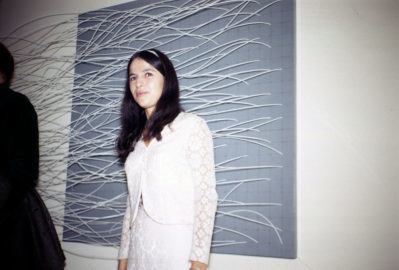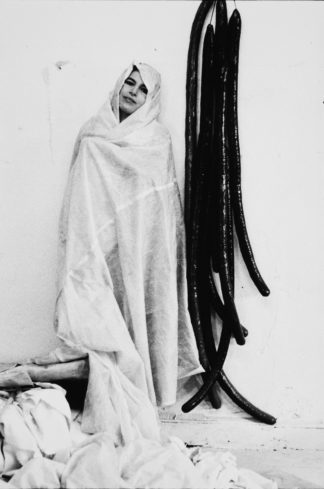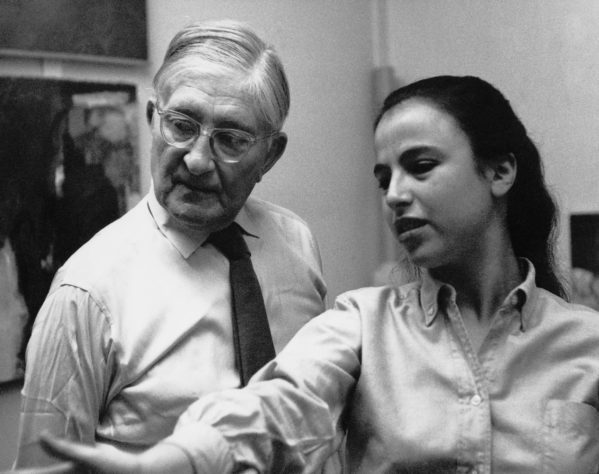INTERVIEW: New film documents influence of iconic artist Eva Hesse

Eva Hesse used a variety of materials, including fiberglass and latex, to create memorable, often startling sculptures. Her career blossomed in the postwar years and helped establish what became known as the post-minimalist movement.
The artist died in 1970, her life and legacy, in many ways, framed by the culture of the 1960s. Today her artistic output is going through a renaissance, thanks to many of her works being put on display in art museums around New York City. She’s also the subject of a new documentary by director Marcie Begleiter and producers Karen S. Shaprio and Michael P. Aust. Eva Hesse, which looks at the artist’s influence and body of work, couples archival footage with new interviews with her contemporaries.
What emerges in the film is a document of New York City’s art scene, one woman’s striving for creativity, a life stopped short by a brain tumor, and visuals and words that tell so many varied stories.
“I went to graduate school for art, and I discovered her work in reproductions, in books,” Begleiter said recently in a phone interview. “Even not seeing the original, even just seeing photographs of the sculptures, I was very drawn to the work, so that’s how I kind of got involved with this in the beginning is through the power of the art work. It was hard. It was soft. It was logical. It was absurd. It was funny. It was serious. It had that thing that great art has, which is that it’s mysterious, and it’s beautiful. And it doesn’t fit into any one particular kind of box.”

The filmmaker’s interest in Hesse’s work eventually led her to a book that was published in 1976, which features many of the artist’s unpublished journals. This had Begleiter thinking about the woman behind the sculptures and perhaps how she broke the rules and dashed expectations.
“A friend of mine who is an art librarian said, ‘Oh, all of that unfinished work is in a little museum in Oberlin, Ohio,’ so I just kind of went on my interests and a hunch,” Begleiter said. “I got a little grant money to go do a research project. I spent a week, 10 days in Oberlin, Ohio, reading through … her journals and her letters, and looking at her original drawings, and that’s really when I became engaged, and interested and had a sense of Eva’s voice, the woman behind the art.”
At first, Begleiter, who is making her feature-length documentary debut with Eva Hesse, wasn’t thinking that film was the means to tell this story. Instead, the filmmaker headed for the stage and wrote a play about the artist. That project, which Begleiter worked on for nearly five years, was produced in the Los Angeles area in 2010. Shapiro came and saw the play, and she asked Begleiter more questions about Hesse.
“She was really engaged with Eva and the material, and wanted to work together to take the play to a larger venue and for a longer run,” Begleiter said. “And at that point, we thought, OK, we’re not going to do that without some sort of engagement with the estate. I had written the play just based on my response to Eva’s written material and her art work, but in terms of taking that project to the next level, it was really important to meet with the estate and meet some of the people Eva knew.”

To get started, the director conducted audio interviews with five people who knew Hesse. She was moved by the testimonies of these sources and impressed that this many decades later they still recalled Hesse’s influence. These five people connected with Hesse on a “deep, emotional level,” Begleiter said.
“I realized at that point that the audio recorder and a written piece was not the best way to tell that story, that I needed to come back with a camera,” she said. “And I have a background as a filmmaker even though this is the first feature documentary that I’ve directed. I’ve worked on plenty of films as an art director and as a storyboard artist, and so it became clear that that would be the best way to tell the story.”
After checking to make sure a documentary on Hesse didn’t already exist, Begleiter began to work in earnest on Eva Hesse. The finished product continues at New York’s Film Forum through Thursday, May 12.
As she continued to explore and interview the artist’s friends and colleagues, Begleiter was struck by the vivid memories and thoughtful comments.
“Eva passed away over 45 years ago, and people were talking about her as if they saw her yesterday,” she said. “So that emotional and personal, intellectual connection they had had with the artist and the woman was still there for them, and that impressed us over and over again, that her memory, her experience of this person was so fresh. We even had one of the people who we interviewed who was 80 at the time, and who had shared a studio with Eva, said, ‘Look, I’m not a young woman. I’ve lost a lot of people in my life. I think about Eva every day, and it doesn’t happen with everyone you lose.’ … There was a power and an intensity that you see in the work, that you feel in the work and that you also read in this writing, which is really a revelation. Most people are not aware that she also wrote so much, and then finally the fact that as a human being the response people had to her was so deep and so lasting.”
Even though Hesse lost her life at a relatively young age, Begleiter doesn’t see Eva Hesse as a tragic tale. The filmmaker characterized the film as sad, but the artist lived her life fully and with many dynamic pieces in her body of work.
“She did more in 34 years then many people in 75 years or even 100 years,” Begleiter said. “She lived a very full life, and she lived it deeply and with commitment. I don’t see it as a tragic story. I don’t think Eva experienced her life as a tragedy.”
By John Soltes / Publisher / John@HollywoodSoapbox.com
Eva Hesse is currently playing at the Film Forum in New York City. Click here for more information.

